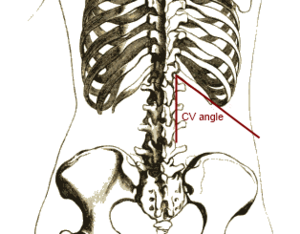Costovertebral angle tenderness
Costovertebral Angle Tenderness
Costovertebral angle tenderness (CVAT), also known as Murphy's punch sign or Pasternacki's sign, is a medical test in which pain is elicited by percussion of the area of the back overlying the kidneys. This test is used to assess for pyelonephritis or other kidney-related conditions.
Anatomy
The costovertebral angle is formed by the 12th rib and the vertebral column. It is located on the posterior side of the body, just lateral to the spine. The kidneys are retroperitoneal organs that lie in this region, making it a useful site for clinical examination.
Clinical Significance
Costovertebral angle tenderness is a classic sign of pyelonephritis, which is an infection of the kidney. It can also indicate other conditions such as renal calculi (kidney stones) or hydronephrosis. The presence of CVAT suggests inflammation or infection of the kidney.
Examination Technique
To assess for costovertebral angle tenderness, the examiner places one hand flat over the costovertebral angle and gently taps it with the other hand. A positive sign is indicated by the patient experiencing pain upon this percussion.
Differential Diagnosis
While CVAT is commonly associated with pyelonephritis, it is important to consider other potential causes of flank pain, such as:
Related pages
Transform your life with W8MD's budget GLP-1 injections from $125.
W8MD offers a medical weight loss program to lose weight in Philadelphia. Our physician-supervised medical weight loss provides:
- Most insurances accepted or discounted self-pay rates. We will obtain insurance prior authorizations if needed.
- Generic GLP1 weight loss injections from $125 for the starting dose.
- Also offer prescription weight loss medications including Phentermine, Qsymia, Diethylpropion, Contrave etc.
NYC weight loss doctor appointments
Start your NYC weight loss journey today at our NYC medical weight loss and Philadelphia medical weight loss clinics.
- Call 718-946-5500 to lose weight in NYC or for medical weight loss in Philadelphia 215-676-2334.
- Tags:NYC medical weight loss, Philadelphia lose weight Zepbound NYC, Budget GLP1 weight loss injections, Wegovy Philadelphia, Wegovy NYC, Philadelphia medical weight loss, Brookly weight loss and Wegovy NYC
|
WikiMD's Wellness Encyclopedia |
| Let Food Be Thy Medicine Medicine Thy Food - Hippocrates |
Medical Disclaimer: WikiMD is not a substitute for professional medical advice. The information on WikiMD is provided as an information resource only, may be incorrect, outdated or misleading, and is not to be used or relied on for any diagnostic or treatment purposes. Please consult your health care provider before making any healthcare decisions or for guidance about a specific medical condition. WikiMD expressly disclaims responsibility, and shall have no liability, for any damages, loss, injury, or liability whatsoever suffered as a result of your reliance on the information contained in this site. By visiting this site you agree to the foregoing terms and conditions, which may from time to time be changed or supplemented by WikiMD. If you do not agree to the foregoing terms and conditions, you should not enter or use this site. See full disclaimer.
Credits:Most images are courtesy of Wikimedia commons, and templates, categories Wikipedia, licensed under CC BY SA or similar.
Contributors: Prab R. Tumpati, MD

